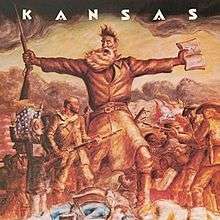Kansas (Kansas album)
| Kansas | ||||
|---|---|---|---|---|
 | ||||
| Studio album by Kansas | ||||
| Released | March 1974 | |||
| Recorded | 1973 at Record Plant Studios "A" and "C", New York City | |||
| Genre | Progressive rock, Boogie Rock, Southern Rock | |||
| Length | 44:58 | |||
| Label |
Kirshner Legacy/Epic | |||
| Producer | Wally Gold | |||
| Kansas chronology | ||||
| ||||
| Singles from Kansas | ||||
|
||||
Kansas is the debut studio album by American progressive rock band Kansas, released in 1974. The album was reissued in remastered format on CD in 2004.[1] A remastered version of the album appeared on vinyl in 2014.
Kansas's debut album followed the merging of two Topeka musical camps: Kerry Livgren, from a previous Kansas line-up, and White Clover, which played mainstream rock and blues. The newly formed group signed with Kirshner Records in 1973 and traveled to New York to record their first release. The material on Kansas, written mostly by guitarist/keyboardist Livgren and vocalist/keyboardist Steve Walsh, had been culled from the repertoire of both groups. Livgren's songs were generally longer and more elaborate than Walsh's and featured mystical lyrics which reflected his intense interest in Eastern religions. "Journey from Mariabronn" was inspired by Hermann Hesse's Narcissus and Goldmund, while "Belexes" and "Aperçu" were influenced by the pseudo-Asian sound of Giacomo Puccini's Turandot.
Kansas was promoted by print advertisements which included the tagline "Kansas is Koming." A promotional 7-inch single titled "Man the Stormcellars: Kansas is Koming!" was sent to radio stations and featured an announcer hyping the album. Two 7-inch singles were released: "Can I Tell You" and "Lonely Wind". Both failed to chart, though a live version of "Lonely Wind" (from the double-live album Two for the Show) did reach the Top 100 in early 1979.
Playlist: Bringing It Back featured five songs from this album and five from Masque.
 |
"Aperçu," by Kansas, from Kansas
Kansas used counterpoint, sudden metrical and stylistic shifts, multi-part compositions, and mystical lyrics much like the British prog bands, but they had more hard rock elements and used violin in an American fiddling style. |
| Problems playing this file? See media help. | |
Artwork
The album cover depicts abolitionist John Brown in a scene from Tragic Prelude, a mural by Kansas native John Steuart Curry. The original mural is painted on a wall at the Kansas State Capitol in Topeka. The album cover image is severely discolored and cropped to show only a small part of the original painting.
Reception
| Professional ratings | |
|---|---|
| Review scores | |
| Source | Rating |
| AllMusic | |
AllMusic's retrospective review gave the nod to the band's mix of progressive rock and boogie rock as being unique, but contended that it also makes them less interesting than other progressive rock bands. They also criticized their ambitiousness as being overdone: "there're a lot of scales and arpeggios, galloping triplets, dramatic organ, and stately ballads that signify nothing and go nowhere."[2]
Track listing
| Side one | ||||
|---|---|---|---|---|
| No. | Title | Writer(s) | Lead vocals | Length |
| 1. | "Can I Tell You" | Rich Williams, Phil Ehart, Dave Hope, Steve Walsh | Steinhardt and Walsh | 3:32 |
| 2. | "Bringing It Back" | J.J. Cale | Steinhardt | 3:33 |
| 3. | "Lonely Wind" | Walsh | Walsh | 4:16 |
| 4. | "Belexes" | Kerry Livgren | Walsh | 4:23 |
| 5. | "Journey from Mariabronn" | Livgren, Walsh | Walsh | 7:55 |
| Side two | ||||
|---|---|---|---|---|
| No. | Title | Writer(s) | Lead vocals | Length |
| 1. | "The Pilgrimage" | Livgren, Walsh | Walsh | 3:42 |
| 2. | "Aperçu" | Livgren, Walsh | Steinhardt and Walsh | 9:54 |
| 3. | "Death of Mother Nature Suite" | Livgren | Steinhardt | 7:43 |
| Bonus track on 2004 CD reissue | ||
|---|---|---|
| No. | Title | Length |
| 9. | "Bringing It Back" (Live) | 9:41 |
Personnel
- Steve Walsh – piano, organ, Fender Rhodes, congas, lead and backing vocals
- Kerry Livgren – guitars, piano, organ, Moog synthesizer, backing vocals
- Robby Steinhardt – violin, lead and backing vocals
- Rich Williams – electric & acoustic guitars
- Dave Hope – bass, backing vocals
- Phil Ehart – drums
- Jay Siegel (from The Tokens) – vocals on "Lonely Wind"
Production
- Producer: Wally Gold
- Engineer: Dan Turbeville
- Assistant Engineers: Kevin "Whip" Herron & Jimmy "Shoes" Iovine
- Mastering: Tom Rabstenek & Greg Caldi
- Cover Design: Ed Lee
- Painting: John Steuart Curry
- Back cover photo: Don Hunstein
Chart positions
Album - Billboard (North America)
| Year | Chart | Position |
|---|---|---|
| 1974 | Pop Albums | 174 |
References
- ↑ Discogs - 21 released versions of the Kansas album
- 1 2 Erlewine, Stephen Thomas. "Allmusic review". Allmusic. All Media Guide. Retrieved 2011-06-15.